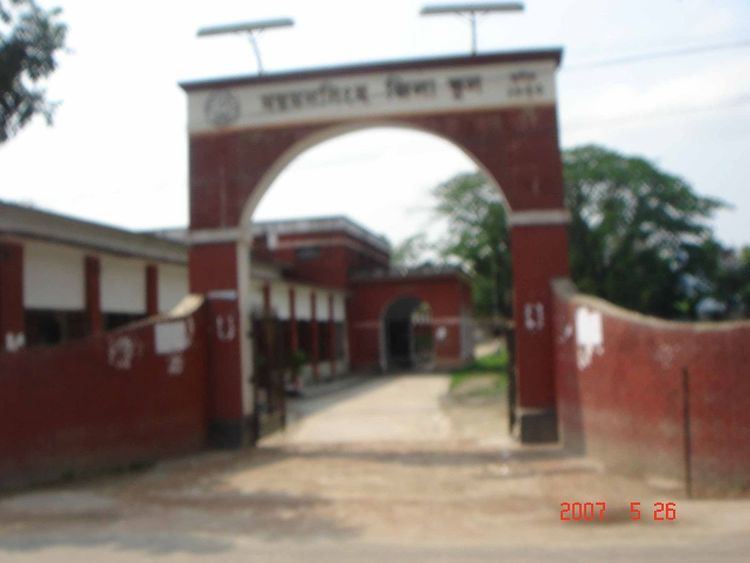Established 1853 (1853) Enrollment 1828 Website mzs.edu.bd Phone +880 91-67550 Founded 1853 | Head teacher Md. Yunus Faruki Number of students 1,828 Faculty 53 | |
 | ||
Type Public secondary school | ||
Icc world t20 flash mob mymensingh zilla school exclusive 15th batch
Mymensingh Zilla School (Bengali: ময়মনসিংহ জিলা স্কুল) is a boys-only school in the city of Mymensingh, Bangladesh. It was established on 4 November 1853. Though it is a Bengali medium school now the school started as an English medium one. Since 1990 the school has been running two shifts, morning and day. The morning shift starts at 7:30 am and the day shift starts at 12:00 pm. The school has two nearby campuses: one is meant for academic and administrative buildings while the other houses the school hostel.
Contents
- Icc world t20 flash mob mymensingh zilla school exclusive 15th batch
- Mymensingh zilla school vs dhanmondi govt boys high school national debate competetion
- History
- Admission
- Academics
- Language
- Mathematics
- Science courses one is optional from the last two
- Business Studies courses
- Others compulsory
- Laboratories
- School hostel
- Auditorium
- Library
- School uniform
- Sports
- Bangladesh National Cadet Corps BNCC
- Notable alumni
- Notable headmasters
- References
Mymensingh zilla school vs dhanmondi govt boys high school national debate competetion
History
Mymensingh Zilla School was established in 1853 during the British Raj, and is one of the oldest schools in Bangladesh. Bhagawan Chandra Bose, father of scientist Jagadish Chandra Bose, was the first headmaster of the school.
In 1846 it started as an English medium school called 'Hardinge School' at Mr. F. B. Camp's, the then Deputy Collector of the East India Company. On 3 November 1853 it started as a full-fledged English medium school near Kachari (present Laboratory School). However, it is no longer an English medium one; it follows the national curriculum of Bangladesh and the medium of instruction is Bengali.
It was called "multilateral pilot school" during the time of first Deputy Commissioner of Mymensingh, S.M.A Kajmi, by the government. The main and present school structures were built in 1912. In 1965 the school compound was designed and reformed by an American science teacher, Mr. Dril.
The school had been used as a base of the British Army during World War II. It was also used as a training camp for freedom fighters during Bangladesh Liberation War in 1971. And more than 40 students sacrificed their lives, that time, fighting against the brutish Pakistan Army.
On 3 March 1981, police fired tear-gas to subdue rioting Mymensingh Zilla School students. Sixty people were injured in the clash, which began when the students attempted to reoccupy part of their school hostel building that the government had recently given over to an adjacent primary training institute.
Admission
Mymensingh Zilla School is a highly selective secondary school and the most competitive one in greater Mymensingh region. Admission, usually in the third and sixth grades, is based on a very competitive admission test administered once a year.
Academics
The school provides education from the third through the tenth grades. Upon successful completion of the eighth grade, students have to choose to be in either the Science or Business Studies stream. However, joining science stream is contingent upon marks obtained in mathematics and general science courses taught at the eighth grade. Since the ninth grade the whole student body, thus, gets separated into two groups: Science and Business Studies. Upon successful completion of the tenth grade the students are allowed to sit for the Secondary School Certificate (S.S.C.) examination.
Language
Mathematics
Science courses (one is optional from the last two)
Business Studies courses
Others (compulsory)
Laboratories
The school provides facilities like science laboratories, projector rooms, workshop, computer lab, covered gymnasium and library. Practical lessons on physics, chemistry, and biology are normally imparted in the science laboratories.
School hostel
There is a hostel for the students who come from outside the city.
Auditorium
There is a spacious and century old auditorium used for cultural events.
Library
There is a library for the students and teachers.
School uniform
The school uniform was introduced in 1968.
Sports
Students regularly participate in different sporting events and games at different levels—local, regional, national—for which prior training and coaching are offered. Popular outdoor games include football, handball, basketball, volleyball, cricket, hockey etc. In addition to this, facilities for different indoor games like chess, table tennis, etc. are also provided.
Bangladesh National Cadet Corps (BNCC)
The school has a strong bncc team which is for all students. All students can join the BNCC. It gives the school good security at all time.
